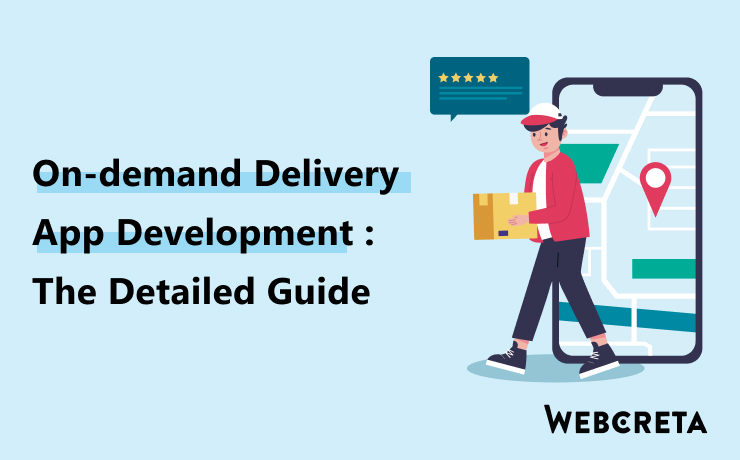On-demand Delivery App Development : The Detailed Guide

Table of Contents
On-demand delivery apps have transformed the way we access goods and services. From food to groceries and everything in between, these apps offer unparalleled convenience.In this comprehensive guide, we’re diving deep into the world of on-demand delivery app development. We’ll unravel the magic behind popular services, explore what makes these apps so unique and user-friendly, dissect the technologies that power them, crunch the numbers to understand the costs involved in starting such a business, and wrap it all up with some key takeaways. So, buckle up as we embark on a journey to uncover the secrets behind the convenience we’ve come to expect from our favorite delivery apps.
What is an On-Demand Delivery App?
An on-demand delivery app is a sophisticated digital platform designed to efficiently connect users with a diverse range of products and services, ensuring swift and convenient delivery to their specified location. Utilizing the power of technology, these applications have transformed the traditional approach to acquiring goods and services. Users can easily access the app through their smartphones, navigate intuitive interfaces, and seamlessly place orders for various offerings, including food, groceries, and more.
One of the defining features of on-demand delivery apps is their real-time connectivity, allowing users to interact with the platform, track deliveries, and stay informed about order status. The integration of advanced geolocation services ensures accurate delivery to the user’s doorstep. Secure payment gateways provide a safe and reliable financial transaction experience.
Features of On-Demand App
These features contribute to the app’s user-friendliness, efficiency, and overall appeal. Let’s delve into the detailed breakdown of key features:

1. Intuitive User Interfaces: On-demand apps prioritize user-friendliness with interfaces designed for easy navigation. Intuitively placed buttons, clear menus, and straightforward design elements create a seamless and enjoyable user experience.
2. Real-Time Tracking: A standout feature is the real-time tracking functionality, allowing users to monitor the progress of their orders from the moment they are confirmed until they reach their destination. This feature instills confidence and transparency in the delivery process.
3. Secure Payment Options: These apps offer a variety of secure payment gateways, allowing users to make transactions confidently. Credit/debit cards, digital wallets, and other online payment options are seamlessly integrated, ensuring a smooth financial transaction process.
4. Customization and Personalization: Users enjoy the ability to customize their orders according to personal preferences. Whether it’s specifying dietary requirements for food delivery or selecting specific product attributes, customization enhances the user experience.
5. Order History and Favorites: On-demand apps often include features that enable users to view their order history and save favorite items for quick and convenient reordering. This simplifies the user journey, particularly for repeat customers.
6. Rating and Feedback Systems: A robust feedback and rating system empowers users to share their experiences and rate the services received. This feature is not only valuable for users but also provides essential insights for app operators to continually improve service quality.
7. Push Notifications: The integration of push notifications keeps users informed about order status, promotional offers, and important updates. Timely and relevant notifications enhance user engagement and provide crucial information.
8. Seamless Communication Channels: On-demand apps facilitate smooth communication between users, delivery personnel, and customer support. Chat or messaging features allow users to convey specific instructions, inquire about orders, and receive assistance when needed.
9.Search and Filter Options: To simplify the browsing experience, these apps incorporate robust search and filter functionalities. Users can quickly locate specific products or services, filter results based on preferences, and efficiently navigate the app.
10. Loyalty Programs and Discounts: Many on-demand apps incentivize user loyalty through integrated reward programs and discounts. These features encourage repeat usage and contribute to the establishment of a loyal user base.
11. Multi-Platform Accessibility: To cater to a diverse user base, on-demand apps often provide multi-platform accessibility. Whether users prefer iOS or Android, ensuring compatibility across different devices enhances the app’s accessibility.
Benefits of On-demand Delivery apps
On-demand delivery apps bring a spectrum of advantages to users and businesses alike:

1. Time-Saving Convenience: Users save valuable time by accessing goods and services with a few taps, all from the comfort of their homes.
2. Diverse Product Range: A wide array of offerings, from groceries to tech gadgets, caters to diverse user needs, offering a comprehensive one-stop solution.
3. Real-Time Control: Real-time tracking provides users with control and transparency, enhancing confidence in the delivery process.
4. Extended Market Reach: Businesses benefit from an expanded market reach, connecting with a broader audience and transcending geographical constraints.
5. Operational Efficiency: For businesses, streamlined operations and automated processes contribute to efficiency and reduced errors.
6. Feedback-Driven Improvement: Feedback and rating systems facilitate continuous improvement, ensuring the enhancement of service quality.
7. Cost-Effective Solutions: Users enjoy cost-effective solutions through discounts, loyalty programs, and promotional offers.
8. Job Creation and Gig Economy: On-demand apps contribute to the gig economy, creating flexible work opportunities for individuals.
9. Sustainability Initiatives: Some apps actively engage in sustainability, optimizing routes and adopting eco-friendly practices.
10. Enhanced Customer Engagement: Push notifications and targeted promotions enhance customer engagement, fostering a connection with the app.
11. Adaptability to Trends: On-demand apps swiftly adapt to consumer trends, staying relevant with evolving preferences and technologies.
Best On-Demand App Development Concepts
1. On Demand App For Healthcare App Development
Ever wished for a personal health assistant right at your fingertips? Well, that’s the magic of on-demand healthcare apps like MedNow and HealthPilot. These apps not only bring your prescribed medications to your doorstep but also connect you with healthcare professionals virtually. Picture having a quick chat with a doctor without leaving your home! Plus, they help you effortlessly keep tabs on your health metrics, making sure your well-being is in your control, anytime, anywhere.

2. On Demand App For Household Needs App
Balancing household chores can be challenging, but not with a household needs app. Find trusted service providers for cleaning, repairs, and grocery shopping with just a few taps. It’s super easy to use, just like those popular apps like TaskRabbit or Handy, where you can get all sorts of things fixed or spruced up, as you might have heard of. You can check out what other people say about the services, see exactly how much you’ll pay, and even track the person helping you in real-time. It’s like having a really dependable friend who knows all the best people to get your home in tip-top shape!

3. On Demand App For Courier Delivery App
Whether you’re a business owner or an individual sending a parcel, a courier delivery app is your go-to solution. These delivery apps like Postmates and Instacart. These apps are like superheroes in the world of logistics. These apps are like superheroes in the world of logistics. They let you track packages in real-time, opt for express deliveries, and let the app optimize the route for efficiency. Say goodbye to logistics headaches and hello to swift and secure deliveries.

4. On Demand App For Food and Drinks Delivery App
Feeling hungry and dreaming of your go-to meal or a fun snack? Well, here’s the deal – a food and drinks delivery app is like a magic wand for your cravings, just think of big names like Uber Eats or DoorDash. It brings all sorts of yummy foods right to your doorstep. You can pick from lots of different types of meals, order your favorite snacks, and even get your preferred drinks delivered. So, when you’re in the mood for something tasty, let this app be your food genie, making sure delicious treats show up right when you want them!

5. On Demand Travel App Development
Planning your next adventure is made easy with travel apps like TripAdvisor and Booking.com. These apps are like your personal travel companions, helping you book flights, find fantastic accommodations, and discover hidden gems at your destination. Your phone essentially becomes your travel sidekick, taking care of the nitty-gritty logistics so you can focus on creating amazing memories during your journey. It’s like having a travel-savvy friend in your pocket.

How do Delivery Apps like Uber Eats and DoorDash Work?
Delving into the operational mechanics of industry giants like Uber Eats and DoorDash unveils a carefully orchestrated process that seamlessly connects users, restaurants, and delivery partners. A detailed analysis reveals the following key components:
1. User Interface and Order Placement: The process begins with a user-friendly interface allowing customers to browse through a diverse array of restaurants and menu options. Users can customize orders, add items to their cart, and proceed to checkout with a few taps on their mobile devices.
2. Real-Time Order Processing: Once an order is placed, the app’s backend system efficiently processes the request in real-time. This involves confirming the order details, verifying payment, and generating a digital receipt.
3. Restaurant Integration: The app interfaces with partner restaurants, seamlessly transmitting the order details to their systems. This integration ensures accuracy and timely preparation of the requested items.
4. Dispatch and Delivery Assignment: Simultaneously, the app identifies the nearest available delivery partner. Advanced algorithms consider factors such as proximity, traffic conditions, and order size to optimize the assignment process.
5. Real-Time Tracking for Users: A hallmark feature is real-time tracking, allowing users to monitor the progress of their orders from preparation to delivery. This enhances user experience by providing transparency and estimated delivery times.
6. Delivery Partner Interface: Delivery partners receive detailed information about the order and the optimal route for delivery through their dedicated interfaces. They can communicate with the user and the restaurant if needed, ensuring a smooth delivery process.
7. Secure Payment Transactions: The app’s secure payment gateway facilitates seamless and secure financial transactions. Users can choose from various payment methods, including credit/debit cards, digital wallets, and other online options.
8. User and Restaurant Ratings: Post-delivery, users have the opportunity to rate their experience and provide feedback. Similarly, restaurants and delivery partners receive ratings, fostering accountability and continuous improvement.
9. Data Analytics for Optimization: Both Uber Eats and DoorDash leverage data analytics to optimize their operations. This includes analyzing user preferences, delivery times, and popular menu items to enhance the overall efficiency and user satisfaction.
10. Dynamic Surge Pricing: During peak times or high-demand situations, dynamic pricing models may come into play. This surge pricing aims to balance supply and demand, incentivizing more delivery partners to join the network during busy periods.
Unique Selling Points of On-Demand Delivery Apps
Monetizing a hotel booking website is a vital aspect of creating a sustainable business. Let’s explore the various strategies and detailed points to effectively generate revenue from your platform:
1. 24/7 Accessibility: One of the standout features is the round-the-clock accessibility of on-demand delivery apps. Users can satisfy their cravings or fulfill needs at any hour, providing unparalleled convenience and flexibility.
2. Diverse Range of Options: These apps boast an extensive array of products and services, ranging from local cuisines and groceries to specialty items. The diverse options cater to a wide range of user preferences and needs, becoming a comprehensive solution for various.
3. Advanced Recommendation Algorithms: Many on-demand apps employ sophisticated recommendation algorithms. These algorithms analyze user preferences, order history, and popular items to provide personalized recommendations, enhancing the overall user experience.
4. Loyalty Programs and Discounts: Implementing loyalty programs and regular discounts is a strategic USP. Users are incentivized to stick to a particular platform, fostering loyalty, while discounts attract new users and encourage repeat business.
5. Community and Social Features: Certain apps integrate community and social features, allowing users to share recommendations, reviews, and even collaborate on group orders. This social engagement enhances the sense of community and adds a social aspect to the app.
Technologies Used for On-Demand Delivery App Development
1. Mobile App Development: The choice between native and cross-platform development involves considerations of user interface and experience design for optimal functionality.
2. Backend Systems: A robust architecture, efficient database management, and seamless API integration form the backbone of on-demand apps, ensuring smooth operations.
3. Geolocation and Tracking: The integration of GPS and mapping services enables accurate real-time tracking, a critical component for user and delivery personnel interaction.
4. Payment Integration: Secure payment gateways and digital wallet options streamline financial transactions, prioritizing the privacy and security of users.
What is the Cost to Start an On-demand Delivery Business?
1. App Development Costs: The initial investment encompasses various elements such as app design, development, and rigorous testing phases.
2. Maintenance Costs: Ongoing expenses include regular updates, improvements, and server maintenance to keep the app current and efficient.
3. Marketing and Promotion: Building brand awareness and acquiring users involve strategic marketing efforts, contributing to the overall success of the on-demand delivery business.
Conclusion
In wrapping up our detailed guide on on-demand delivery app development, we’ve navigated through the intricacies that power the likes of Uber Eats and DoorDash. We’ve decoded the features making these apps user-friendly, unraveled the tech powering their efficiency, and explored the unique traits setting them apart. From understanding the costs involved in starting your own delivery venture to envisioning the ever-evolving future of on-demand services, this guide serves as a compass in the dynamic landscape of app-driven convenience.
At Webcreta Technologies, we stand as your trusted partner in the dynamic realm of mobile and web application development. Our dedicated team is committed to turning your visions into reality, crafting innovative and user-centric solutions. As a leading mobile and web application development company, we pride ourselves on harnessing cutting-edge technologies to create seamless, intuitive, and scalable applications that meet the unique needs of your business. With a focus on excellence and a passion for innovation, we are your go-to destination for transforming ideas into powerful, feature-rich applications that elevate your digital presence.
Reach out today to revolutionize the on-demand delivery landscape with our expertise in mobile app development — your ideas, our innovation!



